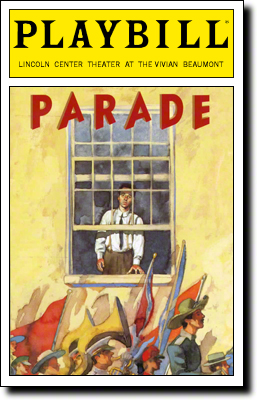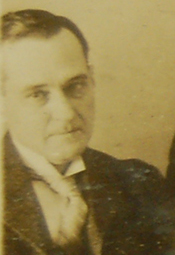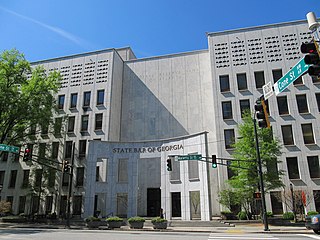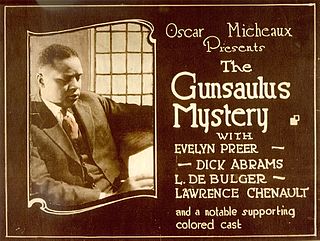
Marietta is a city in and the county seat of Cobb County, Georgia, United States. At the 2020 census, the city had a population of 60,972. The 2019 estimate was 60,867, making it one of Atlanta's largest suburbs. Marietta is the fourth largest of the principal cities by population of the Atlanta metropolitan area.

Leo Max Frank was an American lynching victim convicted in 1913 of the murder of 13-year-old Mary Phagan, an employee in a factory in Atlanta, Georgia where he was the superintendent. Frank's trial, conviction, and unsuccessful appeals attracted national attention. His kidnapping from prison and lynching became the focus of social, regional, political, and racial concerns, particularly regarding antisemitism. Modern researchers generally agree that Frank was wrongly convicted.

"Fiddlin'" John Carson was an American musician and singer who is widely considered to be one of the early pioneers of country music.

Oakland Cemetery is one of the largest cemetery green spaces in Atlanta, Georgia, U.S. Founded as Atlanta Cemetery in 1850 on six acres (2.4 hectares) of land southeast of the city, it was renamed in 1872 to reflect the large number of oak and magnolia trees growing in the area. By that time, the city had grown and the cemetery had enlarged correspondingly to the current 48 acres (190,000 m2). Since then, Atlanta has continued to expand so that the cemetery is now located in the center of the city. Oakland is an excellent example of a Victorian-style cemetery, and reflects the "garden cemetery" movement started and exemplified by Mount Auburn Cemetery in Massachusetts.
Tom W. Loyless, now best known as the manager owner of the Warm Springs spa resort, owned by George Foster Peabody. Prior to managing the resort, Loyless, a native of west Georgia, served as a newspaper reporter, editor and publisher at papers in Augusta, Columbus and Macon. He was " one of the South's leading editorial voices, known for his fierce commentaries and a temper that matched."

Parade is a musical with a book by Alfred Uhry and music and lyrics by Jason Robert Brown. The musical is a dramatization of the 1913 trial and imprisonment, and 1915 lynching, of Jewish American Leo Frank in Georgia.

Joseph Mackey Brown was an American politician. He served two non-consecutive terms as the 59th governor of Georgia, the first from 1909 to 1911 and the second from 1912 to 1913. He has also been posthumously implicated as one of the ringleaders in the lynching of Leo Frank.
The Murder of Mary Phagan is a 1988 American two-part television miniseries starring Jack Lemmon about the murder of a 13-year-old factory worker and the subsequent trial of her accused murderer Leo Frank. The supporting cast features Richard Jordan, Robert Prosky, Peter Gallagher, Kathryn Walker, Rebecca Miller, Paul Dooley, Charles Dutton, Kevin Spacey, Cynthia Nixon, Dylan Baker and William H. Macy.

They Won't Forget is a 1937 American drama film directed by Mervyn LeRoy and starring Claude Rains, Gloria Dickson, Edward Norris, and Lana Turner, in her feature debut. It was based on a novel by Ward Greene called Death in the Deep South, which was in turn a fictionalized account of a real-life case: the trial and subsequent lynching of Leo Frank after the murder of Mary Phagan in 1913.

Hugh Manson Dorsey was an American lawyer who was notable as the prosecuting attorney in the Leo Frank prosecution of 1913, that subsequently led to a lynching after Frank's death sentence was reduced to life imprisonment. He was also a politician, a member of the Democratic Party, who was twice elected as the Governor of Georgia (1917–1921) and jurist who served for more than a decade as a superior court judge (1935–1948) in Atlanta.

Nathaniel Edwin Harris was an American lawyer and politician, and the 61st Governor of Georgia.

The Georgia Historical Commission was an organization created by the U.S. state of Georgia for purposes of historic preservation. The Georgia legislature created it in February 1951 to promote and increase knowledge and understanding of the history of Georgia. Its work, including the erection of hundreds of historical markers, was accomplished during a relatively brief existence. These markers are still standing today. The impetus for the creation of the commission came from several sources as local historical societies were launching restoration projects of statewide importance.

William Marcellus Howard was a noted jurist and politician from the American state of Georgia.

Eugene Herbert Clay was an American politician who served as the mayor of Marietta, Georgia, and one of the ringleaders in the lynching of Leo Frank.

The State Bar of Georgia is the governing body of the legal profession in the State of Georgia, operating under the supervision of the Supreme Court of Georgia. Membership is a condition of admission to practice law in Georgia.

The Moore's Ford lynchings, also known as the 1946 Georgia lynching, refers to the July 25, 1946, murders of four young African Americans by a mob of white men. Tradition says that the murders were committed on Moore's Ford Bridge in Walton and Oconee counties between Monroe and Watkinsville, but the four victims, two married couples, were shot and killed on a nearby dirt road.

The Gunsaulus Mystery is a 1921 American silent race film directed, produced, and written by Oscar Micheaux. The film was inspired by events and figures in the 1913–1915 trial of Leo Frank for the murder of Mary Phagan. The film is now believed to be lost. Micheaux remade the film 1935 as Murder in Harlem.
The Jewish American Society for Historic Preservation (JASHP) is an American non-profit 501(c)(3) volunteer historical society. The society locates sites of American and Jewish historical interest and importance. It works with local community organizations, synagogues, churches, historical societies, governments and individuals, to erect interpretive historical markers that help illuminate the American-Jewish experience and reflect on the commonality of being American.
The history of the Jews in Atlanta began in the early years of the city's settlement, and the Jewish community continues to grow today. In its early decades, the Jewish community was largely made up of German Jewish immigrants who quickly assimilated and were active in broader Atlanta society. As with the rest of Atlanta, the Jewish community was affected greatly by the American Civil War. In the late 19th century, a wave of Jewish migration from Eastern Europe brought less wealthy, Yiddish-speaking Jews to the area, in stark contrast to the established Jewish community. The community was deeply impacted by the Leo Frank case in 1913–1915, which caused many to re-evaluate what it meant to be Jewish in Atlanta and the South, and largely scarred the generation of Jews in the city who lived through it.

The statue of Thomas E. Watson is a public monument located near the Georgia State Capitol in Atlanta, Georgia. Dedicated in 1932, the statue honors Georgian politician Thomas E. Watson, who served terms in the United States Congress as both a Representative and Senator in the late 1800s and early 1900s. Originally located on the steps of the capitol building, the statue was removed from this location in 2013 and relocated to a nearby plaza.



















